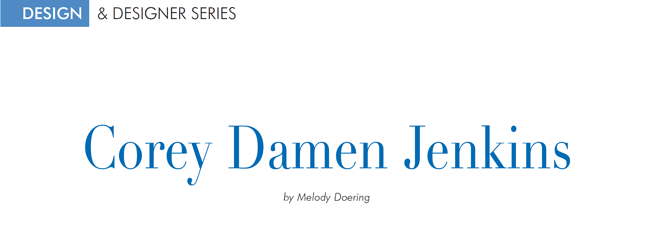
Designer
Corey
Damen Jenkins
literally knocked
on 779 doors
before one opened. He shares his
experience about persistence,
emerging design trends and his observations about retail sales.
Featured this month in Furniture World’s Design and Designer series is acclaimed designer Corey Damen Jenkins. Located in Birmingham, MI (north of metro-Detroit), and New York City, Corey has designed for both commercial and residential spaces. Not limiting himself to any one design aesthetic, Corey’s use of color, patterns, layering, and well-appointed materials results in homes that are “always classic, livable and without an expiration date.”
Mr. Jenkins has been featured in House Beautiful, Traditional Home, Vanity Fair, and Elle Decor, to name only a few. Besides winning HGTV’s Showhouse Showdown, he has earned numerous industry honors. Corey designed for the Kips Bay Decorator Show House in 2019, and has recently appeared as a guest designer on The Rachael Ray Show.
Furniture World began by asking Corey about breaking into interior design.
“I'm from Detroit, a great comeback city, a phoenix that has risen from the ashes. There's a saying here that Detroit hustles harder. As the wellspring of the North American automotive industry, when the recession hit in 2007, Michigan was the first to really suffer.
“It was around that time that I lost my nearly 10-year career working for the automotive Big Three doing commercial design. Back then it was basically a nine-to-five job. I think of it like being a hamster on a wheel – like the classic "9 to 5" song by Dolly Parton.
“At that time here in Detroit, people believed that they would work with one company until retirement. At age 31 this was a heart-rending experience for me and many others who had the rug pulled out from under us.”
Unexpected Career Change
“My dad was CFO for a major banking enterprise; my mother and brothers are also in the financial services business. I think my dad only saw one pathway to success, especially for men of color. It was either working on the line in the automotive industry or getting an office job. The idea being an artist, a fashion designer or interior designer, was completely outside the realm of conversation for him. My family thought I was crazy.
“I applied for dozens of jobs, but at that time, literally thousands of people were vying for one job. So, after not getting any of them, I decided it was the time to take control of my own destiny by launching a design firm.
That's the real lesson. If you are a designer or sell furniture at retail,
that’s how the universe works. You have to hustle.
“First, I developed an interior design presentation and created a website on GoDaddy. Then, I stepped back and waited for the phone to ring. It didn’t!
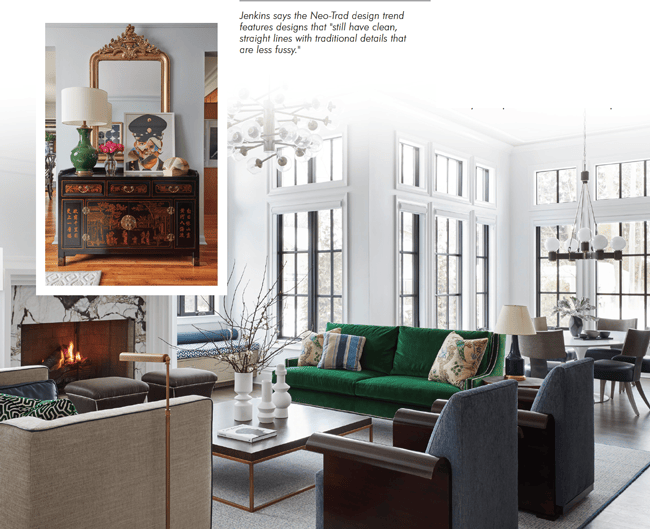
“Collecting unemployment meant having to let go of my fancy condo, beautiful green Volvo sedan and the luxury of healthy shopping at Whole Foods. I decided to go door-to-door looking for my first clients in the suburbs of metro Detroit where high-wealth individuals had large homes.
“Not wanting to drive my old Honda Accord into wealthy, gated communities, I made a deal with the local Enterprise Rent-A-Car to rent me the same car every single time I went looking for clients. They agreed to rent me a black Chrysler 200 sedan. I drove into gated communities in the dead of winter — snow boots, trench coat, scarf, and toting a satchel full of sketches and color boards.”
“Instant” Success
“Over several months I knocked on a total of 779 doors. People would come to the door, look out the peephole and then walk away. If the opportunity to identify myself arose, I would say, ‘My name is Corey Damen Jenkins. I'm an interior designer and decorator. Are you in need of interior design services today?’ That was my simple spiel. Ninety-five percent of the time people either did not answer or said they weren't interested.
“Being turned away, having doors slammed in your face, getting laughed off the construction sites after losing your job does something to your emotional enamel. But in December of 2009, I finally got a warm response. A couple invited me into their home, and offered me hot chocolate and cookies. When people offer hospitality, it's a sign that they look at you as a potential collaborator, possibly even a friend. This couple decided to give me a shot, and proposed a few hundred grand to get started. I played it cool saying, ‘Yes, that's quite acceptable. I'm sure that if we need more, we can discuss that later.’
“When the job was finished, photographed, and uploaded to my little GoDaddy.com website, about two weeks later HGTV contacted me to do my first television show. My first big break came just that quickly.
“When I'm a guest instructor at design schools like Parsons, I tell students that all the pomp and circumstance and the press and accolades are wonderful. But none of that would have happened if I had not first knocked on 779 doors. That's the real lesson. If you are a designer or sell furniture at retail, that’s how the universe works. You have to hustle.”
Hustle and Hospitality
I think we're going to see the pendulum swing back more towards what I
call neo-traditional. It’s
a clean look with a bit more embellishment. It’s also been called Minimalist-Trad. |
“When I walk into an average furniture store, first I look to see if their designs are in step with where the industry is going, and if they look like they are interested in forging strong relationships with members of the design community.
“Then I look for the hospitality. Too many times when I enter a manufacturer’s showroom in High Point or a retail furniture store, nobody bothers to provide a proper greeting or offer help. If it doesn’t happen in the first five minutes, I'm gone.
“When shoppers feel that they are not worth acknowledging, it comes across as just plain rude. It’s understandable that salespeople get caught up in the rat race, but if they forget that they're in a customer service position, don’t hustle, or have trouble focusing on potential customers, it's an automatic turnoff for people – and one of my biggest peeves. Just about everyone is pleased to be asked if they need help and maybe offered a cup of coffee.
“I like to shop at stores that make their retail environments hospitable, warm and inviting. Displays should be laid out in an attractive way that's easy to absorb and easy for people who may not have design training to find their way around and make decisions. That goes a long way towards how any retailer is perceived as a brand.”
That Goes for Websites, Too
“The same rules apply to retail websites. They have to be laid out so that they are easy to navigate, with products that can be found and purchased quickly.
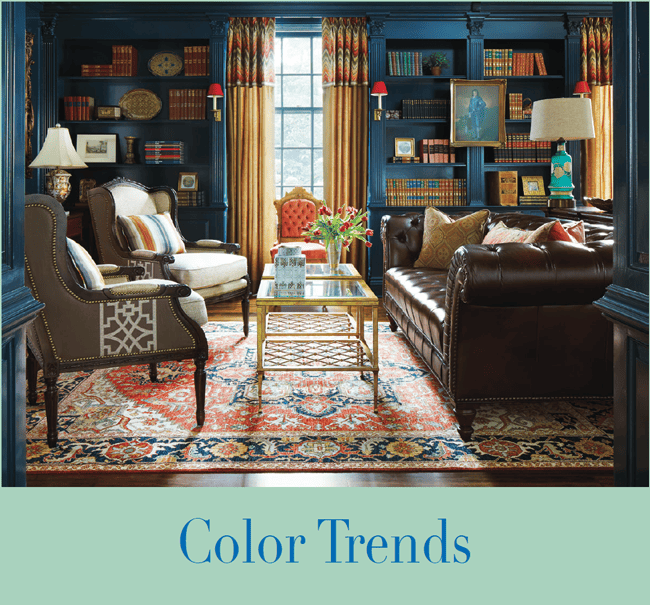
"A retail space that is beautifully outfitted in emerald green, sapphire blue and gold will attract attention," says Jenkins. “Even if
most customers will ultimately play it safe
with neutrals, it’s worth taking risks with
presentation." Pictured below is a Bloomfield Hills, Michigan, home library designed by Jenkins, courtesy of Traditional Home/Meredith Corporation.
|
“People are in a hurry; they're trying to get through their day. Often retail furnishings websites are not equipped with enough key searchable words to find a specific product, even though that product is probably there. Retailers need to make sure designers and retail customers can more easily find items and information.”
Collaboration With the Design Community
“When interior designers visit furniture shows, they are looking for ways to grow their businesses. To do that, obviously they have to be able to make a profit. The same is true when designers shop online or at local retail furniture stores.
The question for retailers who want to do business with the design community is how to develop programs that are a win-win for the store, designers, and the clients who appreciate products that are not mass produced or available everywhere.”
How Will Customers Vote?
“Furniture retailers are like politicians running for office. Politicians benefit from understanding the needs of their constituents. They take polls. They talk to supporters and others in their communities face-to-face.
“Without good information, sales associates are not in a great position to service their customers’ needs or give them what they want.
“There is a lot to be said for asking shoppers point-blank questions and for developing questionnaires to collect information. Questions might include, do you have a personal or favorite decorative style? Favorite colors? What kind of budget are you working with? Who do you look to for design inspiration? What furniture or fashion websites have you visited recently? Do you look to Pinterest or Instagram for design ideas? How might you describe your lifestyle?
“If you ask these questions often enough, you start to get a sense of where your shoppers’ general ideas and aspirations lie.”
Furniture retailers are like politicians running for office.
Politicians benefit from understanding the needs of their constituents.
They take polls.
They talk to supporters and the others in their
communities face-to-face.
Gathering Data
“Making house calls is one of the most effective ways to quickly understand potential clients’ lifestyles, family situations, design preferences, and items needing replacing.
|
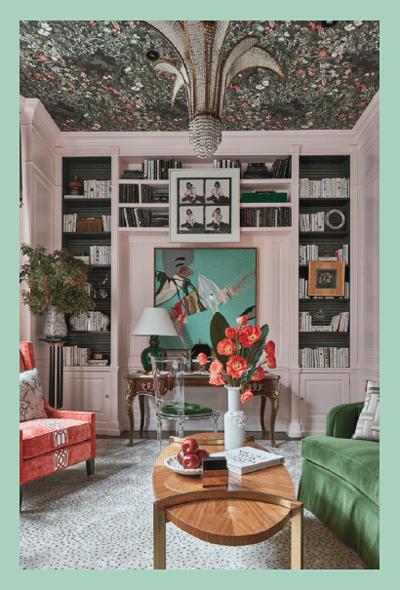
Pictured above is a room Jenkins
designed for the Kips Bay Show House
in New York City benefiting the Kips Bay Boys & Girls Club. It's a charity he supports that raises funds for education, and provides other resources for about 10,000 inner city
children. He converted a formal "gentleman's study" into a ladies library featuring a
dramatic mural on the ceiling, modern
furnishings by Kravet and a snow leopard print rug from Stark.
|
“I’ve found that there’s often a herd mentality that develops in certain communities based on word of mouth and what neighbors, friends and family are thinking about in terms of design and furnishings. For example, people who live in a certain area may favor shabby chic, bohemian, traditional or mid-century modern.
“Collecting and sharing this data within retail organizations can be helpful to designers as well as retailers. Both groups need to better answer these two important questions: what do my customers need; and, what are they likely to vote for with their wallets. Just like running for political office – now you're getting votes because your platform reflects the constituents in the area you serve. It's a very simple science.”
Generational Trends
“There are definitely changes in consuming and buying behaviors among the generations.
"Although a lot of young people I work with in their 30s and 40s are financially well off, they're still concerned about the costs of raising children, funding their 401Ks, and saving for tuition.
“They don’t have the same mindset as their parents. They may not want to purchase a high-end Baker sofa, even though that's probably a better long-term investment. Instead they want to hit up an online retailer and get a sofa for 300 bucks. It serves their purpose for the short-term, but it will need to be replaced in a couple of years. They seem to be okay with that.
“Our industry needs to help the younger generation understand and appreciate the value of quality furniture. There's an opportunity for designers and retail design associates to convince them to repair and recover their grandmother’s wonderful old sofa. Customers will benefit by having a cool vintage item, a comfortable and sustainable investment. They will also save money that can be used to purchase new furniture and accessory items from quality retailers.”
Usage Trends
“More of my clients are asking for casual dining spaces attached to kitchens. The days of families having formal dinners at six o'clock when the kids get home from school are over. Great dining room spaces are not getting used at all. They're just sitting there collecting dust except on Christmas or Thanksgiving.
“My clients are also choosing to invest much more in their exterior spaces. They are looking for competitively priced outdoor furniture with gorgeous, colorful fabric choices. They want pattern as well — basically the same personalized options they have for interior spaces, including nice rugs and fabrics. That's an opportunity for many retailers.
“Consumers are also looking for ways to make their homes smarter with USB drive outlets everywhere. Clients are asking us for places to charge devices in the bedroom, the bathroom, and in their theater seating. There are lots of different ways the components of technology are advancing the conversation about how we furnish the home.
“We're also designing a lot of multipurpose spaces these days, where children can do homework as well as play, work on puzzles, or wrap gifts for the holidays. These rooms incorporate storage to put away all of that gift-wrapping paper, board games and toys. I expect that furniture retailers who have not already adjusted their floor space allocations to include multi-functional furniture and storage will be negatively impacted going forward.”
Minimal or Maximal?
“Ten years ago the pendulum had swung very hard toward a mid-century modern look. It’s been said that for every action there's an equal and opposite reaction; I think we're going to see the pendulum swing back more towards what I call neo-traditional. It’s a clean look with a bit more embellishment. It’s also been called Minimalist-Trad.
“Furniture designs will celebrate clean, straight lines with traditional details that are less fussy.
In order to get display ideas, consider following the fashion runway or the
Met fashion show with its beautiful people in amazing, over-the-top costumes that you and I probably wouldn’t wear. |
“I adore Mario Buatta’s work, but we are still years away from seeing those types of designs reappear in a different vernacular. I don't think we're ready to see full- blown maximalist design coming back in a big way yet.
“Pattern is used judiciously in my work. Many of my more mature clients, who tend to prefer a traditional design approach, have asked me to restrict pattern play to accent pillows or window treatment trim, versus wrapping the entire sofa in a bold patterned fabric. My younger clients also appreciate pattern, but they are more likely to incorporate it into table-top accessories, or a lamp shade versus a larger investment.”
Color Trends
“Many retailers have a monochromatic approach to product display. For Restoration Hardware this is part of their corporate branding - the grays, whites and earth tones. It’s a neutral story that works for them. Other retailers and manufacturers have created their own version of that.
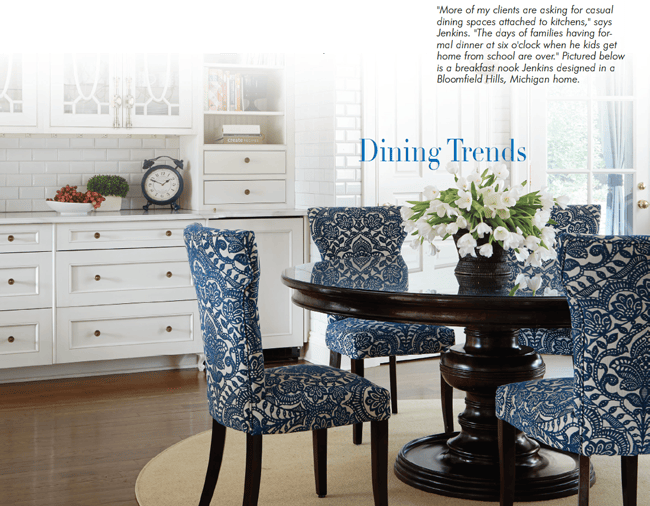
“But many of my clients reside in areas where it is dreary outside for a large portion of the year – in the greater New York area, Michigan, Minneapolis and Toronto. They don't want gray. They want vibrant color, jewel tones and pattern. The pendulum is starting to swing, forcing a lot of retailers to become a bit more individualized in their approach when it comes to how they style their showrooms and their websites.
“Fashion and interior design are tied together, with trends in fashion tending to lead the way. So, it’s important to look to the fashion runway. I keep an eye on Valentino, Elie Saab, and Jean Paul Gaultier. The current color palettes seen there now reflect vibrant color, with blushes, pinks and golds. These trends will eventually seep into interior design and dominate one or two years from now.”
Color is Nothing to Fear
“Virtually 100 percent of the people who fill out our client questionnaires say they want to incorporate more color and pattern in their homes. Yet they are terrified of adding it themselves; they don’t know where to start or when to stop. That’s why they hire designers and why they visit stores to get ideas. Here is a consumer need we in the furniture industry can fulfill.
“Many sports teams use bold, vibrant color palettes. If you are a fan of the NBA or NFL, ask yourself why the uniforms are so colorful. The answer is that it focuses spectator attention on the playing field in a way that an all-white uniform or an all-gray uniform just can’t. Here in Detroit, the Lions are outfitted in silver and Cobalt blue. It doesn’t help us win, but it does help the fans focus on the game. Likewise, getting shoppers to spend more time in stores in a focused way is a big part of playing the retail game.
I expect that furniture retailers who have not already adjusted their floor space allocations to include multi-functional furniture and storage will be negatively impacted going forward.
“Speaking practically, since just about everyone loves some shade of green or blue, consider incorporating vibrant jewel tones to arrest the eye in a way that white and gray simply does not. Neutrals can be the supporting actors in displays. A retail space that is beautifully outfitted in emerald green, sapphire blue and gold will attract attention.
“Even if most customers will ultimately play it safe with neutrals, it’s worth taking risks with presentation. It’s about knocking on those doors not knowing who is going to answer but knowing that you are putting forth an eye-catching statement that’s different from your competitors.”
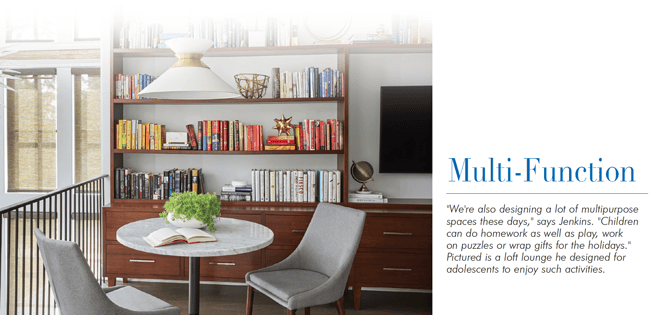
Where To Find Great Ideas
“In order to get display ideas, consider following the fashion runway, or the Met fashion show with its beautiful people in amazing, over-the-top costumes that you and I probably wouldn’t wear. The purpose is to push the imagination and appeal to the human senses.
“I subscribe to House Beautiful, Veranda, Traditional Home, Elle Decor, and Architectural Digest. These are industry leaders in showing what can be done to push the envelope for interior design. Aside from staying focused on fashion, I look to nature and also ancient civilizations — the Greeks, Romans, Medo-Persians, and Egyptians. Their architecture and color choices are vibrant in a way that remains influential thousands of years later.
“For creative people and retailers, there are almost limitless sources of inspiration for buying and designing, including museums, outdoor spaces, historic sites and domestic and international travel.”
One More Design Resource
“The Bienenstock Library in High Point, NC, is incredibly impressive. It's a resource that the design community at large needs to know about and take more advantage of. The building’s architecture is fascinating and beautiful. More important, however, is what it contains – a bevy of information designers and decorators can take advantage of and benefit from.
“Designers often come to High Point Market to find better resources for clients and projects. Many times, the creative process starts with finding inspiration. The collection at the Library gives designers an ideal place to start, grab a cup of coffee, and get an additional dose of inspiration before they shop the High Point Market.
“The library has everything from the Chippendale experience, to Saarinen, and so much more under one roof. It’s easily accessible for students, design enthusiasts, veterans and newbies who are coming up in the industry. I can’t think of a better way to grow: as individuals and as a society, we benefit from learning from the past and engaging the present. That is what will dictate our future.
“As a furniture designer, I know that it's very difficult to reinvent the chair. There are certain things you just can't get around as far as the form and function of furniture. But if you look at what’s been classically tested, remix it, tweak this, change that, make it more useful for the present, and for the future, then you may be on to something. That’s why this library can play a key role for designers who are looking for ways to make their clients' homes look their best.”
Future Plans
“Besides my existing collections with Leathercraft and Hudson Valley Lighting, I have recently signed new deals with DownTown Company and Leftbank Art. I'm also planning to introduce an exciting textile, rug and wall covering collection with a premier fabric house in the near future. My first coffee table book is coming soon on the Rizzoli International publishing label. So, we are very busy.”
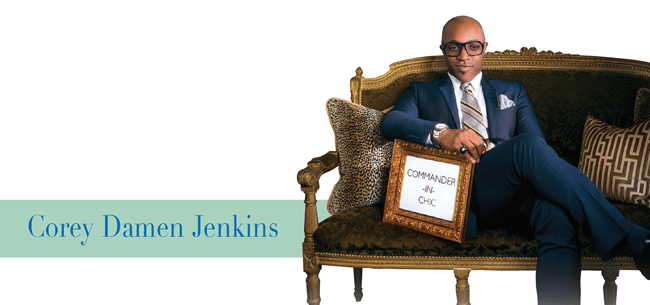
Russell Bienenstock is Editor-in-Chief of Furniture World Magazine, founded 1870. Comments can be directed to him at editor@furninfo.com.